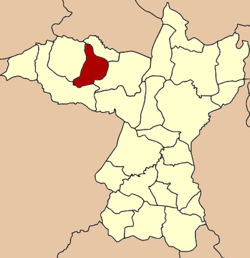Wiang Kao District
Wiang Kao (Thai: เวียงเก่า, pronounced [wīa̯ŋ kàw]) is a district (amphoe) of Khon Kaen Province, northeastern Thailand.
Wiang Kao เวียงเก่า | |
|---|---|
 District location in Khon Kaen Province | |
| Coordinates: 16°40′43″N 102°17′40″E | |
| Country | Thailand |
| Province | Khon Kaen |
| Seat | Nai Mueang |
| Area | |
| • Total | 286.0 km2 (110.4 sq mi) |
| Population (2005) | |
| • Total | 19,750 |
| • Density | 69.1/km2 (179/sq mi) |
| Time zone | UTC+7 (ICT) |
| Postal code | 40140 |
| Geocode | 4029 |
History
The major district (king amphoe) was created by splitting three tambons from Phu Wiang District. Its creation became effective on 1 May 2006.[1]
On 15 May 2007, all 81 minor districts were upgraded to full districts.[2] With publication in the Royal Gazette on 24 August the upgrade became official.[3]
Geography
Neighboring districts are (from the north clockwise) Nong Na Kham, Phu Wiang, Chum Phae, and Si Chomphu.
The district is in the Phu Wiang mountains, parts of it in Phu Wiang National Park. In 1976 dinosaur fossils were discovered in the district. Since 2001 the discovery sites are accessible in the Phu Wiang Dinosaur Museum.
Administration
The district is divided into three sub-districts (tambons), which are further subdivided into 36 villages (mubans). There are no municipal (thesaban) areas, and a further three ambon administrative organizations (TAO).
| No. | Name | Thai name | Villages | Pop. | |
|---|---|---|---|---|---|
| 1. | Nai Mueang | ในเมือง | 15 | 8,957 | |
| 2. | Mueang Kao Phatthana | เมืองเก่าพัฒนา | 10 | 5,857 | |
| 3. | Khao Noi | เขาน้อย | 11 | 4,936 |
References
- ประกาศกระทรวงมหาดไทย เรื่อง แบ่งเขตท้องที่อำเภอภูเวียง จังหวัดขอนแก่น ตั้งเป็นกิ่งอำเภอเวียงเก่า (PDF). Royal Gazette (in Thai). 123 (49 ง): 5. 16 May 2006.
- แถลงผลการประชุม ครม. ประจำวันที่ 15 พ.ค. 2550 (in Thai). Manager Online.
- พระราชกฤษฎีกาตั้งอำเภอฆ้องชัย...และอำเภอเหล่าเสือโก้ก พ.ศ. ๒๕๕๐ (PDF). Royal Gazette (in Thai). 124 (46 ก): 14–21. 24 August 2007.